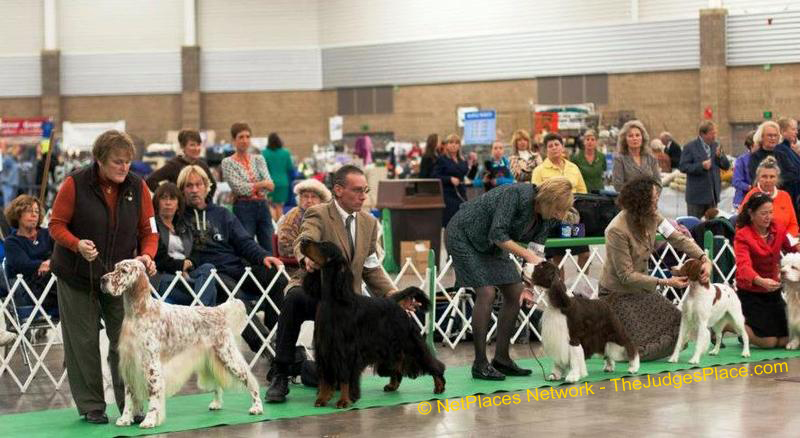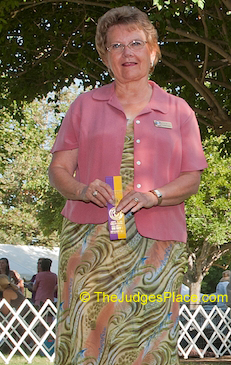BREED STANDARD AND EXAGGERATION
E. "Katie" Gammill, Exhibition Editor, AKC Multi-Group Judge
Multi-Group judge notes many Group winners today display exaggerated size, bone, and coat. Is that a good way to make one dog stand out more than another?
How many Group winners today “push the envelope” regarding exaggerated size, bone, and coat. When judging what makes one dog stand out more than another? Shouldn’t dogs representing their respective standards regarding size, bone and coat be rewarded for adhering to the standard?
 When is a good dog NOT a good dog? A beautiful dog with exaggerated structure, movement, conditioning and showmanship does not necessary mean it IS a good dog. It may be so heavily boned or coated that is appears as another breed. All judges at one time or another have stood in the Group Ring with beautiful dogs but had a problem when it came to “just what breed is this?” A sound, conditioned dog that lacks breed type just doesn’t cut it, and this happens too often today.
When is a good dog NOT a good dog? A beautiful dog with exaggerated structure, movement, conditioning and showmanship does not necessary mean it IS a good dog. It may be so heavily boned or coated that is appears as another breed. All judges at one time or another have stood in the Group Ring with beautiful dogs but had a problem when it came to “just what breed is this?” A sound, conditioned dog that lacks breed type just doesn’t cut it, and this happens too often today.
We have three sizes in dogs today which are toy, moderate, and giant. Whether watching or judging the Groups, if the Australian Shepherd is the same size as the Bernese Mountain dog, something may be wrong. What if the Bernese has a head the size of the Saint? A Great Dane lacking head type with a roached top line may appear as a sighthound. Malamute males should be 25” and 85 pounds but what if the Malamute’s size rivals the Tibetan Mastiff's?
One is wrong. Ridgebacks often exceed 27” by far, yet they are awarded. Read their standard to understand their genetic makeup and wonder when “too much is too much”. Occasionally a moderate breed will have a head the size of a Saint. Too much in a Siberian and it appears a Malamute. Some toys challenge the “moderate” breed standards while some moderate breeds lean toward Giants in size. The standard Poodles size states 15” and over. How much over 15 inches is allowable? Coming from a 16” measurable breed, I marvel at the size of some Standard Poodles in the ring.
Granted, many breed standards don’t have a DQ, but does this mean we can show whatever we want even if it is in exaggeration? When in judging do we dismiss?
Many breeds today are too bulky. A tiny round foot may be “cute” but is it functional and correct? What about excessive bone? Too many coats are cut back to create a silhouette. Too many puppies finish from puppy class and are never seen again once mature. An example of this is my national where puppy classes are HUGE and the open classes dwindle to exceedingly small entries.
Who is responsible for over-done puppies finishing early? The breeder? The judges? Perhaps, many know puppies that are competitive in the 6-9 class against open entries often have no place to go once they mature.
Judges need to develop an eye for size and weight. Use the reference of another moderate breed to consider correctness in a breed of a designated size or weight. The Australia Cattle Dog can be “18-20” for males. Most substantial ACD will weigh in approximately 55 pounds so consider the Norwegian Elkhound male at 20-1/2” and the fact males are 55# and bitches can be 48”. It’s comparative.
The male German Shepherd is 24-26” and bitches at 22-24” and the Siberian is M 21-23 ½” and bitches 20-22”. They may have different body shapes but by studying one against another, it gives one something to gauge against in another breed. The Rhodesian Ridgeback dog is 25” to 27” and bitches are 24” to 26”, males at 85# and bitches are 70#. Think about when you see it in the Best in Show ring with the Newfoundland at 29” and 26” weighing 130 to 150 pounds.
If the Ridgeback and the Newfoundland appear the same size... ONE OF THEM IS WRONG!
It is educational to take the standards to the Group ring. If one breed appears exaggerated, “out of whack” size or weight-wise, look up the required size and note it compared to others in the ring. This is an education in itself and helps one develop an eye for correctness. Judges are equally responsible for putting up dogs that are impressive and oversize as the breeders are when they bring them in the ring.
 Promoting a dog for exaggeration gives breeders false signals to what truly IS correct. Judges should avoid rewarding overdone dogs as well as dogs that appear weedy or spindly. It goes back to what is required in the standard and why should one breed a dog correct to standard even though the dog with the exaggeration received the accolades.
Promoting a dog for exaggeration gives breeders false signals to what truly IS correct. Judges should avoid rewarding overdone dogs as well as dogs that appear weedy or spindly. It goes back to what is required in the standard and why should one breed a dog correct to standard even though the dog with the exaggeration received the accolades.
Coming from a measurable breed and knowing the weight of dogs at home gives one a good idea regarding size. Knowing approximately where 26” in when you stand in the ring can assist one regarding size if there is NO DQ in the standard. Judges do not have to award a dog that stands out if it is in direct opposition to the desired size or weight in a standard. Sitting ringside with the standards in tow gives one a great opportunity to analyze these attributes against other breeds.
As long as breeders choose to finish dogs that push the envelope, judges will continue to reward them. Eventually size becomes a serious problem. It the same with exaggerated heads, over angulated rears, and massive bone and coat. To appreciate dogs that are exaggerated and produce needed breed attributes is one thing, but to promote them to the determent of the breed simply for the wins is another thing. Most breeders know when a dog is too much.
Judges must accept the responsibility of knowing when a dog pushes the envelope. If so, perhaps dogs that are fine specimens of their Breed Standard will take their place and become a template for us all.
Another Great Article by E. Katie Gammill; Veteran Class Judging, Katie shares her view of this most SPECIAL class filled with emotion, memories and canine grandeur.
TheJudgesPlace.com EST 2005 ©
Jun 2019 https://www.thejudgesplace.com/Judges-view/breed-standard-exaggeration-k19G6.asp
MeetDog Show Judges - Ring Steward, Free & Share buttons, Visit Links

The Ring Steward says "Go back to
a Judges View From The Center Ring!" We invite you to learn how the Judges view the sport and the dogs. Dog Show Judges share their judging expertise, backgrounds, and opinions in exclusive interviews and comments.
Courtesy NetPlaces Network, World's First Online Purebred Dog Information


The world’s 1st public website (TheDogPlace.org) from Animal Health to Vaccines.
The world's 1st online dog news, (TheDogPress.com) from AKC records to zoological news.
The world's 1st site by/for dog show judges (TheJudgesPlace.com) educates on purebred dogs.
Privacy Policy ~ Disclaimer ~ Web Contact